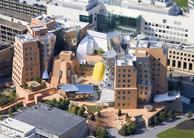The Glass House as Gay Space: Exploring the Intersection of Homosexuality and Architecture
By
2012, Vol. 4 No. 06 | pg. 1/1
KEYWORDS:
Philip Johnson is, without a doubt, one of the most famous architects of the 20th century. He was also gay, a fact known to some in his intimate social circle but certainly not to most in his field and absolutely not to the general public. His outward repression of his homosexuality was most likely shrewd self-preservation--mainstream America did not smile upon non-traditional lifestyles at the time--but it ultimately manifested itself in fascinating ways through Johnson’s architecture. Perhaps most notably, Johnson’s celebrated Glass House can be subjected to a thorough queer analysis, particularly in terms of its stylistic suggestions and sly, satirical motifs. The Glass House’s glass walls represent for Johnson a parodic paradox of closeted homosexual life in the mid-twentieth century: anyone can see into the central space, into the living room which represents so many centuries of traditional family living, yet the goings-on inside the house are an utter inversion of the sexual-societal norm. The house’s visitors were often gay, but just as gay people hid in plain sight, so to did the visitors exhibit their homosexuality within the Glass House while perpetually protected by the sheer barrier of the glass walls. In addition, the Glass House contains the visual pun of its own Guest House, located only yards away. While the Glass House’s walls are a transparent closet door, the totally enclosed Guest House represents the true closet, the repression of self, the claustrophobically enclosed space in which gay people are forced to relegate their hearts and souls. Taken as a whole, this piece of property provides magnificent insight into Johnson’s attitudes and beliefs, and it serves as a marvelous example of gay-influenced, gay-oriented 20th century architecture.
The fact of Johnson’s homosexuality was, as previously mentioned, hidden from the general public, although it was known to “his friends and to a broad circle of colleagues and critics.”6 Still, his homosexuality was “never openly acknowledged,” nor was it “publicly discussed in connection with his life and work.”7 Even after Johnson came out, few critics dared draw a connection between his work and his sexuality until a groundbreaking article by Alice T. Friedman on which some of this analysis is based. Yet Friedman’s article really only scratches the surface of the queer implications of the Glass House. In truth, the house is a pie in the face of the homophobes described above, so quietly and cleverly does it incorporate the question of sexual identity into its design. Most prominently, the gayness of the space is part of the notion of “camp.” The term, in its most basic sense, describes “those elements in a person, situation, or activity that express, or are created by, a gay sensibility.”8 Camp is never “a thing or person per se, but rather a relationship between activities, individuals, situations, and gayness.”9 In other words, camp is not homosexuality, but how homosexuality resolves itself through actions or words or, in this case, art. Considering this fact, one might easily interpret the Glass House solely as an exercise in camp, an outlet through which Johnson could resolve his decidedly unresolved10 homosexual inclinations. Consider, for instance, the aforementioned paradox of transparency/secrecy. In theory, the house--and by extension, its inhabitants--should be easily penetrable by outsiders. Yet its inhabitants were most often secretly gay men, and no one knew it. What is the purpose of this duplicity, this visual chicanery? It ties back, of course, to camp. According to queer theorist Jack Babuscio, there are four elements of camp: irony, aestheticism, theatricality, and humor.11 Each of these is present in the Glass House. The irony--that the world world could look in on gay men inhabiting an aesthetically pleasing setting and not understand that they are gay--is obvious, as is the inherent humor of this contradiction. The question of theatricality is thornier. According to Babuscio, to appreciate or utilize camp is to “perceive the notion of life-as-theater, being versus role-playing, reality and appearance.”12 With this set of alluring contradictions in mind, it is possible to parse the theatrical undertones of Johnson’s work. Consider once again the atmosphere in which a mid-century gay man lived. In a society already hostile to gays, there was in the 1940s a “growing antipathy toward ‘fairies’ and ‘queers’”;13 the shocking pervasiveness of homophobia at the time is well-established. There was only one way to escape the persecution: to hide one’s true nature in any way one could. For many gay men, this was accomplished by playing a role which came artificially to them, basically impersonating heterosexuals for the sake of survival. But not everyone is a born actor, and many gay men14 were forced to find outlets for their unsuppressible homosexual tendencies.15 These outlets were often wit and sarcasm, as homophobic misgivings could sometimes be swept away by a splendid bon mot or a biting one-liner. And so with its sheer walls and well-lit interior, the Glass House became a kind of stage for Johnson and his friends, a metaphor and a mockery of society, a space in which they were verbally free to act on whatever homosexual tendencies they desired. The architect and his “glamorous company”16 were finally allowed to be honest with themselves, knowing that their words would reach no one and that their lighthearted socializing betrayed no deep brewing secret under its surface calm. The inhabitants of the Glass House could drop their acting and no one would know. The casual onlooker might think she understood everything going on in the house, but from afar with no sound, she would be entirely in the dark. This is a large part of the genius of the Glass House, the culmination of its ironic campiness. Johnson turned his house into a safe place where gay people could hide in plain sight, and the joke was lost on decades of followers, enemies, critics, authors, and even other architects. Digging even deeper, there is another joke at play here which maximizes the genius of the Glass House as a gay space. One major aspect of homophobia which grew in the middle part of the century was an illogical defense of the traditional nuclear family and family home. Many middle-class men perceived growing cultural “threats...to their very status and prerogatives as men.”17 To them, “social patterns and cultural expectations were being challenged or undermined”18 by changing sex and gender roles. Gay men “provoked a high degree of anxiety and scorn” among many middle-class heterosexual men, for they “represented in extreme form the loss of manhood”19 and the destruction of the traditional family. The home, then, increasingly became the last defense, a fortress against the encroaching cultural and societal sea change, a bastion of conventionality. With the Glass House, Philip Johnson put homosexuality in the home. He tore down societal barriers and created a gay space meant to be inhabited by gay men including, for at least part of the time, a long-term same-sex couple.20 The implications of this are explosive. Prior to gay liberation (which might be dated to the Stonewall Riots of 1968 and even up to the early 2000s), gay people were expected to live on the fringes of society, relegated to lives as outcasts apart from the mainstream. The lucky ones, like Johnson, found a home among accepting, progressive, often artistic communities, but most either remained hidden or lived a life of solitude and sadness. The Glass House rejects this rather depressing quandary, and offers a different idea: what if gay men were allowed to live the same way, and inhabit the same space as, heterosexuals? What if a home were built for the express purpose of homosexual living? Would the whole construct of middle-class masculinity simply fall into ruins, taking down with it the class family model? In fact, no: Johnson’s Glass House did not herald the end of the social order as we know it. Instead, it insouciantly pointed toward a kind of equality that was rarely even articulated in those years. And still it was more than meaningful--it was also funny: heterosexual culture was being turned on its head, yet no one had any idea. To allow the world to gaze in on this novel paradigm of gay living was a bold move, but Johnson never showed his hand and thus never provoked the ire of the public at large. The term “safe space,” already conjured once in this essay, again comes to mind, for the home, be it a heterosexual or homosexual one,21 is always a stronghold of safety and comfort. Johnson and his friends could be campy, but they could also make themselves at home, and this is vital to the queer nature of the Glass House. The work upended middle-class mores (even if no one knew it), in a sense predating the societal upheaval which was to shake the next few decades to their core. No discussion of the Glass House’s gayness would be complete, however, without mention of the Guest House. Separated by a patch of grass and placed diagonally from the Glass House, the Guest House echoes and inverts the basic tenets of the Glass House. It, too, is eye-catchingly boxy, geometrically simple and quite confined space-wise. Yet it is also entirely enclosed, with virtually no windows to allow light in. It is, in a word, the anti-Glass House. And yet a view of the two structures together makes a metaphorical point which no single structure could ever accomplish. Its closed-in nature means that the Guest House is everything the Glass House is not; it is secret, hidden, concealed, closed-in, tucked-away. There is no thrill of voyeurism contained in a view of the Guest House; it is the opposite of transparent. It keeps out the light, and with it all the symbolic components of light: truth, beauty, clarity, happiness, understanding. The symbolism here is clear. In modern parlance, the Guest House is the closet. It is where gay men like Johnson were forced to spend most of their time, the place which they came to the Glass House to escape. Its presence is a powerful reminder that no matter how clever or campy or ironic or queer the Glass House was, it would always be an escape, a diversion. Mainstream society was still virulently homophobic, and most gay men could not be open and honest and still prosper (or even survive) in regular society. If only for this reason, the Glass House may be seen as a powerful symbol of gay liberation. It is, without a doubt, a gay space, and its gayness penetrates deep into the heart of its design. But on a simpler level, it is a place of acceptance for homosexuality, a house where the community could gather and stop pretending and enjoy themselves in whatever way they wished. Philip Johnson did the world a favor when he designed the Glass House, and all these decades later, we still marvel at its ingenuity, its irony, and its bizarre beauty. References1.) The Western world’s collective cultural obsession with voyeurism--stretching from Johnson to Hitchcock to Foucault to Antonioni--began around this period; it grew in parallel with many Westerners’ growing obsession with preserving the home as the last frontier of privacy. 2.) Friedman, Alice T. “People Who Live in Glass Houses: Edith Farnsworth, Ludwig Mies van der Rohe, and Philip Johnson” in Women and the Making of the Modern House. New York: Henry N. Abrams, inc., 1998. Pg. 154. 3.) D’Emilio, John. Sexual Politics, Sexual Communities: The Making of a Homosexual Minority in the United States, 1940-1970. Chicago: University of Chicago Press, 1998. Pg. 40. 4.) Ibid. 41. 5.) Ibid. 46. 6.) Friedman, “People Who Live in Glass Houses,” 148. 7.) Ibid. Johnson specifically requested that the New Yorker conceal his homosexuality in a 1977 profile of the architect, fearing it would cost him his commission to design the AT&T building. 8.) Babuscio, Jack. “Camp and the Gay Sensibility” in Camp Grounds: Style and Homosexuality. David Bergman, ed. Amherst: University of Massachusetts Press, 1993, 19-38. Pg. 20. 9.) Ibid. 10.) The architect suffered a mental breakdown at Harvard which he later attributed to a personal crisis over his homosexuality. 11.) Ibid. 12.) Ibid. 24. 13.) Chauncey, George. Gay New York: Gender, Urban Culture, and the Making of the Gay Male World, 1890-1940. USA: BasicBooks, 1994. Print. Pg. 111. 14.) Because the focus of this essay is on Johnson, a gay man, I will not be extending this article to lesbians, bisexuals, or trans people for the sake of space. An extended discussion of the issue can be found in Bergman’s Camp Grounds (see works cited). 15.) If the use of a phrase like “homosexual tendency” seems regressive, it’s because it is. However, the fact that gay men, like members of any communities, share certain identifiable traits must be accepted for the sake of the argument. For further discussion of this debate, see Wilchins’ Gender Theory, Queer Theory, chapters 4-6 (see bibliography). 16.) Schulze, Franz. Philip Johnson: Life and Work. USA: University of Chicago Press, 1994. Pg. 217. 17.) Chauncy, Gay New York, 111. 18.) Ibid. 19.) Ibid. 115. 20.) Specifically Johnson himself and his partner David Whitney, with whom he lived for 45 years. Whitney was also very prominent in the art world, and it is unclear how Johnson concealed his relationship for so long. There are no interviews before 1990 in which Johnson even makes mention of Whitney’s name. 21.) Again, drawing a distinction here may seem odd, but one must consider the views of society at the time rather than the more progressive notions of the present day. Suggested Reading from Inquiries Journal
Inquiries Journal provides undergraduate and graduate students around the world a platform for the wide dissemination of academic work over a range of core disciplines. Representing the work of students from hundreds of institutions around the globe, Inquiries Journal's large database of academic articles is completely free. Learn more | Blog | Submit Latest in Architecture |












